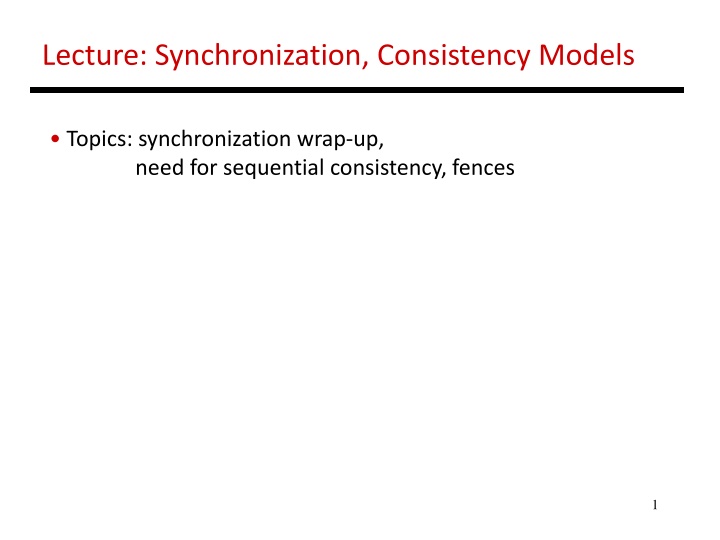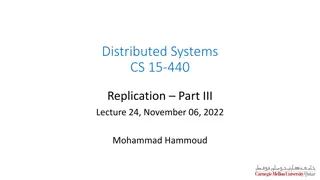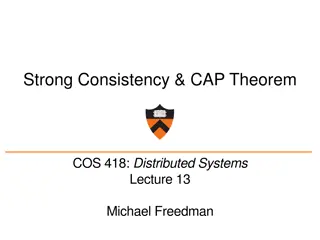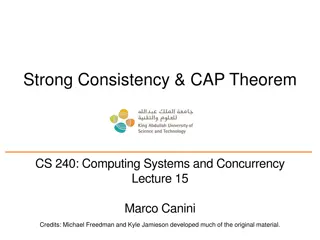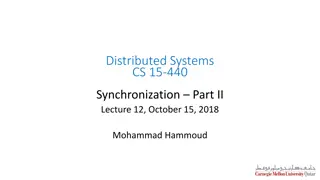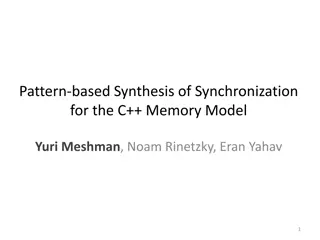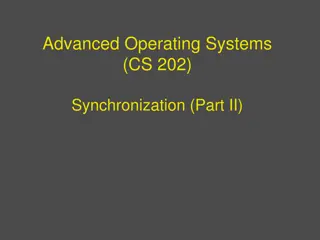Synchronization Models for Consistency
Dive into synchronization and consistency models through topics like wrap-up, sequential consistency, and fences. Explore concepts like Test-and-Test-and-Set lock, Load-Linked and Store Conditional, and Spin Lock with Low Coherence Traffic. Understand how these models work to maintain data integrity in various scenarios.
Download Presentation

Please find below an Image/Link to download the presentation.
The content on the website is provided AS IS for your information and personal use only. It may not be sold, licensed, or shared on other websites without obtaining consent from the author.If you encounter any issues during the download, it is possible that the publisher has removed the file from their server.
You are allowed to download the files provided on this website for personal or commercial use, subject to the condition that they are used lawfully. All files are the property of their respective owners.
The content on the website is provided AS IS for your information and personal use only. It may not be sold, licensed, or shared on other websites without obtaining consent from the author.
E N D
Presentation Transcript
Lecture: Synchronization, Consistency Models Topics: synchronization wrap-up, need for sequential consistency, fences 1
Test-and-Test-and-Set lock: test register, location bnz register, lock t&s register, location bnz register, lock CS st location, #0 2
Load-Linked and Store Conditional LL-SC is an implementation of atomic read-modify-write with very high flexibility LL: read a value and update a table indicating you have read this address, then perform any amount of computation SC: attempt to store a result into the same memory location, the store will succeed only if the table indicates that no other process attempted a store since the local LL (success only if the operation was effectively atomic) SC implementations do not generate bus traffic if the SC fails hence, more efficient than test&test&set 3
Spin Lock with Low Coherence Traffic lockit: LL R2, 0(R1) ; load linked, generates no coherence traffic BNEZ R2, lockit ; not available, keep spinning DADDUI R2, R0, #1 ; put value 1 in R2 SC R2, 0(R1) ; store-conditional succeeds if no one ; updated the lock since the last LL BEQZ R2, lockit ; confirm that SC succeeded, else keep trying If there are i processes waiting for the lock, how many bus transactions happen? 4
Spin Lock with Low Coherence Traffic lockit: LL R2, 0(R1) ; load linked, generates no coherence traffic BNEZ R2, lockit ; not available, keep spinning DADDUI R2, R0, #1 ; put value 1 in R2 SC R2, 0(R1) ; store-conditional succeeds if no one ; updated the lock since the last LL BEQZ R2, lockit ; confirm that SC succeeded, else keep trying If there are i processes waiting for the lock, how many bus transactions happen? 1 write by the releaser + i (or 1) read-miss requests + i (or 1) responses + 1 write by acquirer + 0 (i-1 failed SCs) + i-1 (or 1) read-miss requests + i-1 (or 1) responses (The i/i-1 read misses and responses can be reduced to 1) 5
Lock Vs. Optimistic Concurrency lockit: LL R2, 0(R1) BNEZ R2, lockit DADDUI R2, R0, #1 SC R2, 0(R1) BEQZ R2, lockit Critical Section ST 0(R1), #0 LL-SC is being used to figure out if we were able to acquire the lock without anyone interfering we then enter the critical section If the critical section only involves one memory location, the critical section can be captured within the LL-SC instead of spinning on the lock acquire, you may now be spinning trying to atomically execute the CS tryagain: LL R2, 0(R1) DADDUI R2, R2, R3 SC R2, 0(R1) BEQZ R2, tryagain 6
Coherence Vs. Consistency Recall that coherence guarantees (i) that a write will eventually be seen by other processors, and (ii) write serialization (all processors see writes to the same location in the same order) The consistency model defines the ordering of writes and reads to different memory locations the hardware guarantees a certain consistency model and the programmer attempts to write correct programs with those assumptions 7
Example Programs Initially, A = B = 0 Initially, Head = Data = 0 P1 P2 Data = 2000 while (Head == 0) Head = 1 { } = Data P1 P2 A = 1 B = 1 if (B == 0) if (A == 0) critical section critical section Initially, A = B = 0 P1 P2 P3 A = 1 if (A == 1) B = 1 if (B == 1) register = A 8
Sequential Consistency P1 P2 Instr-a Instr-A Instr-b Instr-B Instr-c Instr-C Instr-d Instr-D We assume: Within a program, program order is preserved Each instruction executes atomically Instructions from different threads can be interleaved arbitrarily Valid executions: abAcBCDdeE or ABCDEFabGc or abcAdBe or aAbBcCdDeE or .. 9
Problem 1 What are possible outputs for the program below? Assume x=y=0 at the start of the program Thread 1 Thread 2 x = 10 y=20 y = x+y x = y+x Print y 10
Problem 1 What are possible outputs for the program below? Assume x=y=0 at the start of the program Thread 1 Thread 2 A x = 10 a y=20 B y = x+y b x = y+x C Print y Possible scenarios: 5 choose 2 = 10 ABCab ABaCb ABabC AaBCb AaBbC 10 20 20 30 30 AabBC aABCb aABbC aAbBC abABC 50 30 30 50 30 11
Sequential Consistency Programmers assume SC; makes it much easier to reason about program behavior Hardware innovations can disrupt the SC model For example, if we assume write buffers, or out-of-order execution, or if we drop ACKS in the coherence protocol, the previous programs yield unexpected outputs 12
Consistency Example - I An ooo core will see no dependence between instructions dealing with A and instructions dealing with B; those operations can therefore be re-ordered; this is fine for a single thread, but not for multiple threads Initially A = B = 0 P1 P2 A 1 B 1 if (B == 0) if (A == 0) Crit.Section Crit.Section The consistency model lets the programmer know what assumptions they can make about the hardware s reordering capabilities 13
Consistency Example - 2 Initially, A = B = 0 P1 P2 P3 A = 1 if (A == 1) B = 1 if (B == 1) register = A If a coherence invalidation didn t require ACKs, we can t confirm that everyone has seen the value of A. 14
Sequential Consistency A multiprocessor is sequentially consistent if the result of the execution is achievable by maintaining program order within a processor and interleaving accesses by different processors in an arbitrary fashion Can implement sequential consistency by requiring the following: program order, write serialization, everyone has seen an update before a value is read very intuitive for the programmer, but extremely slow This is very slow alternatives: Add optimizations to the hardware (e.g., verify loads) Offer a relaxed memory consistency model and fences 15
Relaxed Consistency Models We want an intuitive programming model (such as sequential consistency) and we want high performance We care about data races and re-ordering constraints for some parts of the program and not for others hence, we will relax some of the constraints for sequential consistency for most of the program, but enforce them for specific portions of the code Fence instructions are special instructions that require all previous memory accesses to complete before proceeding (sequential consistency) 16
Fences P1 P2 { { Region of code Region of code with no races with no races } } Fence Fence Acquire_lock Acquire_lock Fence Fence { { Racy code Racy code } } Fence Fence Release_lock Release_lock Fence Fence 17
